The realm of soft plastics’ fishing can be a little confusing with literally hundreds of different soft plastic lure variations available and it can be quite overwhelming when you’re just starting out. But this is only half the challenge. While choosing which plastic is important, knowing which type of jighead to use with certain plastics and in certain conditions is more important.
In fact finding the right combination of hook size, weight and style to complement your plastic is often the biggest key to soft plastic fishing success.
Soft plastic fishers have two main styles of jigheads to choose from and both have specific advantages in different fishing situations and environments.
The first style is the conventional J hook jighead, which is probably the most popular choice of jighead in Australia. Recognised by a forward weighted bullet-like or ball head with an integrated J hook, they are a sound overall option because most plastics are designed to swim with a front weighted twitch or jerk lift action. These jigheads provide an easy option to get maximum action with little effort out of the angler. The problem with conventional J hook jigheads is a large proportion of the hook is exposed, especially around the centre top half of the plastic. This set up makes them easy to snag when thrown tight into structure.
This is especially the case when the jighead used is heavy enough for a quick sink. If the plastic sinks rapidly it leaves no time for the angler to work the soft plastic over the structure and out of danger.
Knowing your weight and how they react in terms of sink rates for different plastics is important if you are choosing a J style of jighead for fishing tight into snags. While this may be a curse in some situations, it is this degree of hook exposure which can significantly increase your hook-up rate, especially on smash and grab style fish like mangrove jack and the sneaky mouthers such as flathead. More hook exposure means the angler has to do less work to ‘sink the hook’ on the initial strike.
One of the biggest issues with conventional J hook jigheads in an estuary scenario is the hooks can be a little small, which can be a problem when trying to fish as light as possible for big saltwater fish such as barramundi. Trying to fish below 1/4oz on this type of jighead means that hook sizes don’t offer a sizable gape, which can be crucial when trying to stay connected to very large fish. Without a lot of gape these jigheads tend to be more prone to dislodging from head shakes.
While fishing tight structure like timber snags and mangroves may be problematic with the conventional J hook jighead they are really in their element over sand covered areas. The front loaded weight tends to puff up sand as the plastic drops back to the bottom creating an excellent attraction for fish like flathead or whiting.
If you prefer to fish without the constant threat of getting snags, then moving away from the conventional J hook set up to a weedless style jighead is the way to go. These ‘all terrain’ rigs consist of a single wide gaped worm hook with an option for an integrated weight mostly located on the belly of the hook. This set up allows for the hook to sit flush with the top of the plastic allowing little room for the hook to snag as it moves through structure.
These jigheads really come into their own where other jigheads would fear to tread. Someone somewhere once said that if you aren’t getting snagged then you are not in the strike zone – well these rigs provide the best of both worlds and allow anglers to fish so deep into structure it’s not funny.
One of the biggest advantages of using a weedless worm hook is the larger hooks and, more importantly, the larger gapes they provide especially when targeting large barra. The large gapes provide plenty of leverage and room to work and when they pin a barra and penetrate through the jaw hinge they very rarely dislodge.
Large gaped weedless rigs can be fished either completely unweighted or with small amounts of weight as well, which means slow sinks that are great for predators like barra which feed from below.
However there is a dark side to this as well and these styles of jigheads do require the angler to firmly set the hook on the initial strike as the lack of hook exposure does tend to see hook-up rates dramatically decrease. On many occasions I have fished side by side with another angler; one fishing the conventional J hook and the other fishing weedless and while the weedless will bring more strikes the J hook tends to provide the greater rate of hook ups and boated fish, especially when chasing smaller species like jacks, bream and flathead.
There are some variations on the conventional J hook jighead and weedless worm hooks and one of the best performing hybrids would have to be the TT Snakeheads. These jigheads incorporate the weedless worm hook however instead of an integrated weight in the belly it is found at the front of the hook like a conventional jighead.
To make things even more interesting the weight is not fixed and is free moving providing plenty of freedom for the plastic to swim and dance. I have also found the free moving weight contributes to greater hook ups as the added front weight tends to help sink the hook deeper on the initial strike. These jigheads are fantastic in every environment and certainly bring a lot of collaborative success from both styles of jighead.
So next time you are pondering over the hundreds of types of plastics on the wall at your local tackle shop, do yourself a favour and spend some time before hand exploring the types of jigheads on offer. There is no chicken or the egg argument here as the jighead will always be tied on first so get this right and everything else tends to fall into place.
Facts
Things to remember
Quality: Only use quality jigheads. Cheaper options are a waste of time and will lead to less hooks ups and breakages.
Hook Gauges: If you are chasing big fish use a heavy gauge hook. Thick gauged hooks are a must for big fish like barramundi and salmon and even big flathead have the potential to bend even the best quality small gauge hooks.
Weight: Fish as light as possible. Conventional J hook jigheads can be very effectively fished through structure if you can weigh the plastic effectively. Similarly you need to consider casting distances and accuracy required.
Whole package: Contemplate the whole package before buying plastics and jigheads. Soft plastic fishing is best fished when specialised or tailored so think about where you will be fishing, what you will be fishing for, what type, size and weight of plastic you will be using.

Rigging plastics with a weedless jighead allows you to fish deep into structure, which is great for snaring big jacks like this.
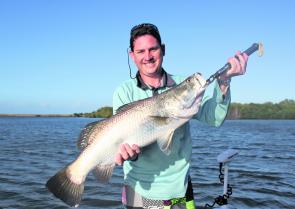
Large barra have large mouths so they are most suited to wide gape hooks like those found on a weedless jighead.
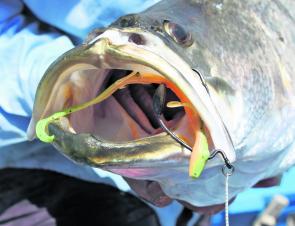
Here you can see the effectiveness of a wide gape weedless jighead on a big barramundi.
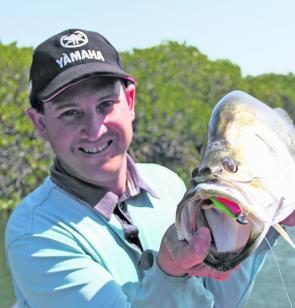
Conventional J hook jigheads can still snare big barra especially if you can get a top jaw hook up like this one. But catch them in the corner of the mouth and your chances drop significantly.

Here a conventional J Hook jighead, which was meant for a flathead, produces the goods on an average jack. The thin gauge of this jighead would prove problematic on a better quality fish.
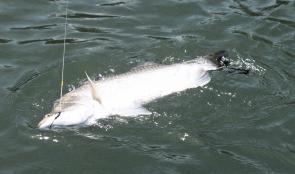
The weedless jighead accounts for another barra this time under the jaw from a missed swipe. The advantage of the large gape often means even poor hook ups stay connected.
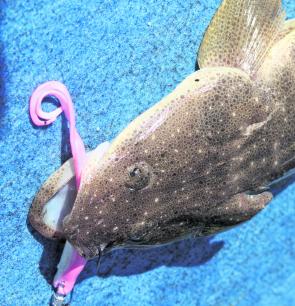
Conventional J hook jigheads are well suited to sand species as the angler doesn’t have to worry about snagging.
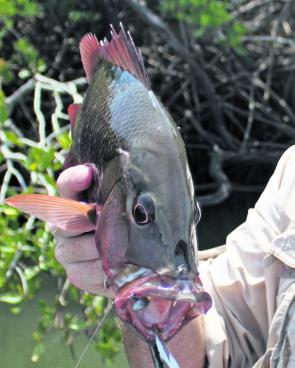
Dave Redsell with a J hook jighead snared jack. With a light weighted jighead he was able to float this plastic around the snags and catch this great fish.




